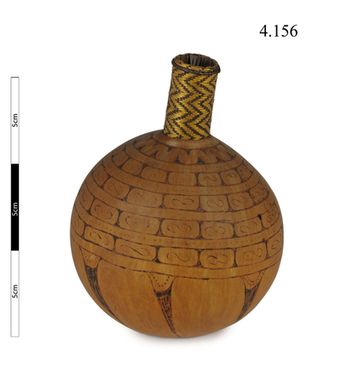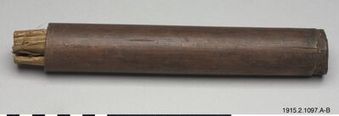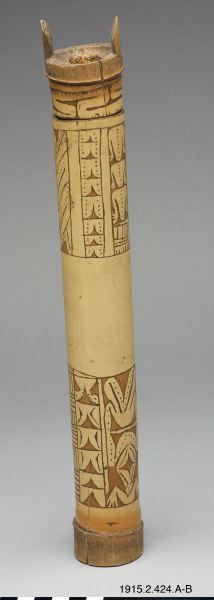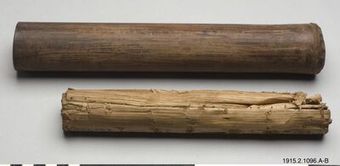Connect with Horniman Museum and Gardens
Contact this content partner to get more information about this item.
container
- Description:
- Lime Gourd, Massim Province, Southeastern Papua New Guinea. The chewing of nuts from the Areca palm (Areca catechu), commonly referred to as betel nut, was a major recreational activity for men throughout the mainland and island groups of New Guinea. This addictive stimulant (Arecoline) was brought into the island in remote prehistory from Southeast Asia. A complex set of artworks and tools have developed over the centuries around the drug’s preparation and consumption. Lime containers are central to the use of betel nut in New Guinea; the alkaline lime powder (usually obtained by finely grinding coral) activates the Arecoline in the nuts, and so it is needed on hand whenever the nut is chewed. Stoppered gourd containers are produced throughout Papua New Guinea, in which the ground limestone is stored, and from which small quantities are periodically removed using a saliva-wetted lime spatula and put in the mouth alongside the nuts. Like these spatulae, the lime gourds created in the Massim region are particularly impressive artworks. Here, a spherical variety of bottle gourd (Lagenaria siceraria) has been pierced, de-seeded and dried, before its remarkable black-inked decorative scheme was applied, and its stopper of rolled leaf and woven cane was manufactured. This scheme is characteristic of the complex scrollwork art developed by the Trobriand Islanders in their other arts, while at the same time exhibiting a remarkable order and uniformity. Gourd, pandanus leaf, vegetable fibre, pigment. Late 19th Century. Formerly in the private collection of Mr W.D. Webster. Small lime gourd constructed from a spherically ground bottle gourd which has a cylindrical stopper in a platted sheath of split vegetable fibre in natural and dark brown colours. The spiral leaf core is missing. The surface of the gourd is pyrograved in a number of attractive scroll designs.
- Format:
- image
- Collections:
- Horniman Museum and Gardens
- Content partner:
- Horniman Museum and Gardens
- Availability:
- Not specified
-
Copyright status: All rights reservedFind out more about what you are able to do with this itemThis item is all rights reserved, with means you'll have to get permission from Horniman Museum and Gardens before using it. For more information, please see our use and reuse page.More informationHorniman Museum and Gardens has this to say about the rights status of this item:
http://rightsstatements.org/vocab/InC/1.0/
What can I do with this item?Non-infringing useNZ copyright law does not prevent every use of a copyright work, and this item may be hosted by an international institute or organisation. You should consider what you can and cannot do with a copyright work.No sharingYou may not copy and/or share this item with others without further permission. This includes posting it on your blog, using it in a presentation, or any other public use.No modifyingYou are not allowed to adapt or remix this item into any other works.No commercial useYou may not use this item commercially.
Welcome and warm Pasifik greetings
The information on this site has been gathered from our content partners.
The names, terms, and labels that we present on the site may contain images or voices of deceased persons and may also reflect the bias, norms, and perspective of the period of time in which they were created. We accept that these may not be appropriate today.
If you have any concerns or questions about an item, please contact us.



